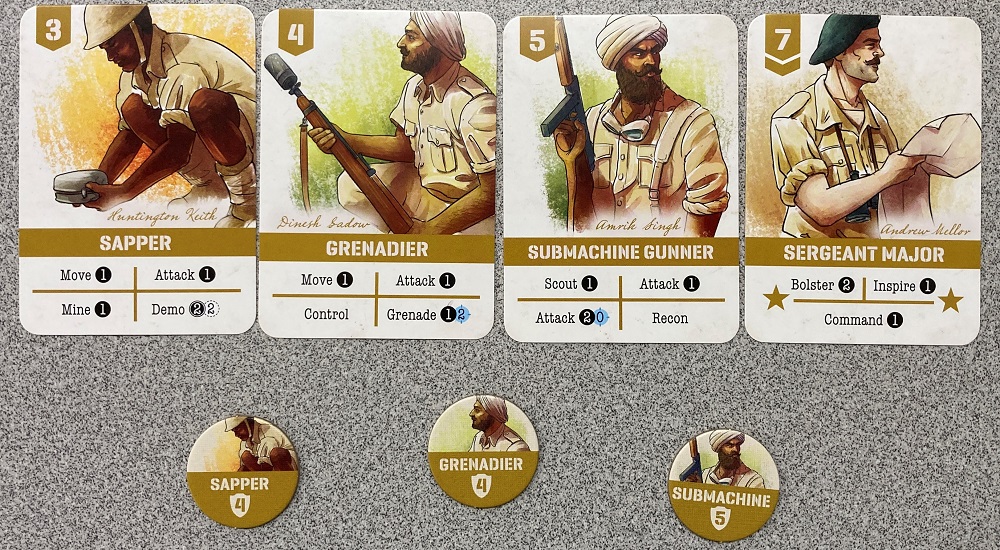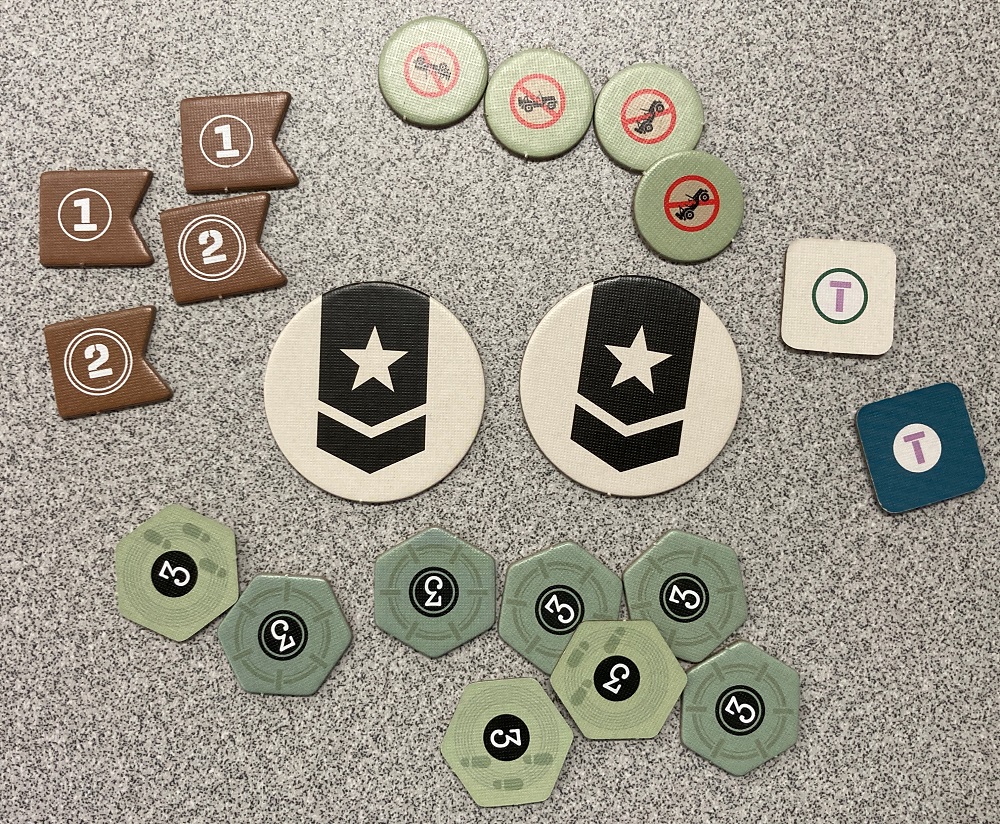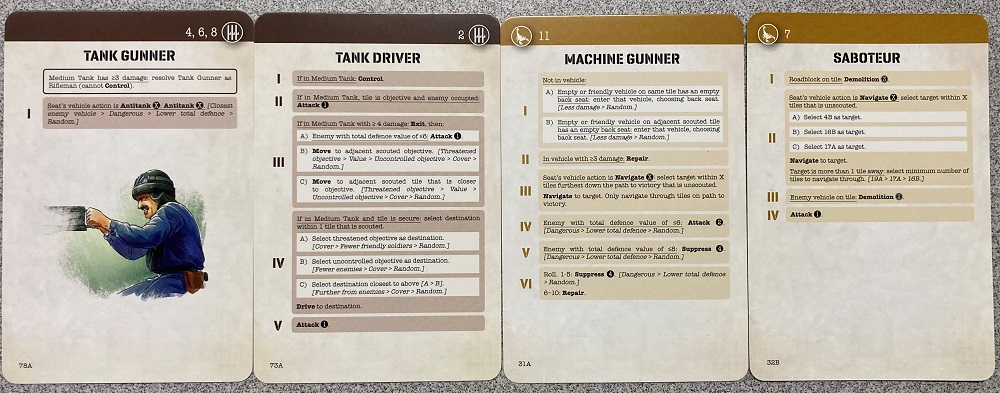Tabletop games that simulate battles, also referred to as wargames, have been around for a number of years. They are often known for their cardboard counters, maps divided into hexagons, and complex rules for everything from moving to attacking to terrain. However, recent wargames have broken the mold and are not only more approachable but also incorporate some interesting mechanics from other types of games. Undaunted: Normandy, released in 2019, was such a game. Undaunted: North Africa, a stand-alone sequel, was released in 2020 and took the series not only to a new location but also added new ways to play. Now Undaunted: Reinforcements has arrived which brings new content for both of the two previous games.
What Is Undaunted: Reinforcements?
Undaunted: Reinforcements is a game expansion for both Undaunted: Normandy as well as Undaunted: North Africa. Either of the base games is required for play. The wargame series is for 1-4 players, ages 14 and up, and takes about 45-60 minutes to play. Undaunted: Reinforcements is currently available from your FLGS or online retailers such as Amazon for a suggested retail price of $48 for a copy of the game. The Undaunted series was designed by David Thompson and Trevor Benjamin, published by Osprey Games, with illustrations by Roland MacDonald.
Undaunted: Reinforcements Components
Here is what you get in the box:
- 13 LRDG (Long Range Desert Group) forces cards
- 14 Italian forces cards
- 16 US forces cards
- 16 German forces cards
- 9 Combat counters
- 150 Solo cards
- 20 tokens and markers
- 1 Rulebook
- 1 Scenario book

The LRDG gain sappers who can place and disarm mines, grenadiers who can attack all of the units in a tile, submachine gunners who gain an extra attack dice when on the same tile as their target, and the sergeant major.

The Italians finally get a sniper along with grenades and submachine guns as well as assault aircraft and the commando leader who can call in air support.

In addition to adding Stuart and Sherman tanks, the US also gets specialists that add grenades to their riflemen squads

The Germans get a Panther tank and a couple of Panzer IV tanks while their riflemen specialists gain submachine guns for extra firepower at close range.

The solo cards direct what the enemy bot units do during their turn and provide a challenge no matter which side you choose to play as. The numbers at the top determine for which scenarios the cards are used. When choosing an action for the unit, just go down the list until you come to the first situation that applies.

New tokens and counters represent the new units as well as mines.
How to Play Undaunted: Reinforcements
Since Undaunted: Reinforcements is an expansion, this section will cover the basics of the game system that apply to both Undaunted: Normandy as well as Undaunted: North Africa.
The Goal
The goal of the game is to complete your side’s victory conditions before the other player completes their victory conditions.
Setup
Start off by selecting a scenario from the scenario book. Next, locate the tiles listed for that scenario and place them as shown in the book. Place objective markers on the map created from the tiles. Players then choose which side they will play and take all the cards, combat counters, control makers, and spawn markers listed in the scenario book for their side. The markers and tokens are now placed on the map as shown in the book. Give the initiative token to the player as indicated by the scenario. Now players go through their side’s cards and assemble their starting deck as listed in the scenario and shuffle these cards together face down. Next, assemble the cards listed for your supply. Sort them by type and place them face up near the player to form their supply piles. After returning any leftover cards to the box, you are ready to play.

Gameplay
Undaunted is played in a series of rounds, each made up of three phases. During the first phase, each player draws four cards from their deck to form a hand. If the deck runs out of cards, shuffle the discard pile to replenish the deck. Next, players determine initiative for the round. To do this, each player secretly selects one card from their hand and place it face down in front of them. At the same time, they reveal their cards. The player who played the card with the highest initiative receives the initiative marker and will perform their actions first for the round. In case of a tie, the player who currently has the initiative keeps it. Both players then discard the card they used for initiative.
Starting with the player who has initiative, the players then play the cards from their hand until they have none left or they do not wish to play any more. As they play cards, the cards remain in the play area in front of them. Once their turn is complete, all cards left in their hand and those in the play area are placed in the discard pile. Then the other player goes and plays their cards. When a card is played, the player chooses one of the actions listed on the card and plays it in full. Or the player may “hunker down” and return the card to the supply.
The cards represent different types of units and leaders. Units are represented on the map by combat counters. The typical infantry unit can move, attack, or control. A move action allows the unit to move a number of tiles listed on its card. Attack lets it attack an enemy unit with the number of dice indicated. The control action lets the unit take control of a tile. Units can only move onto a tile that has already been scouted. Therefore, you need to send out your scout units to scout out tiles so other units may follow behind them. For each tile they scout, you add a fog of war card to your discard pile. Fog of war cards have no actions and essentially reduce the number of actions you can take during a turn. Luckily, Scout units can perform a recon action which allows you to take a fog of war card from your hand and remove it from the game. You can then draw a card from your deck into your hand to replace it.
Leader cards represent individuals that support the units but do not have counters on the map. They have some great actions that can really help you. Bolster allows you to take a number of cards from your supply piles and add them to your discard pile. This essentially adds opportunities to use those units in future rounds. Command lets you draw a certain amount of cards from your deck and add them to your hand so you can then play them this round—essentially giving you more actions. The inspire action lets you choose cards from your play area, those you already played this round, and add them back into your hand. This lets you play the same cards a second time during the same round. As you can see, leaders are really force multipliers for their side.
Combat is fairly simple. When you choose to attack with a unit, the number next to the attack order represents the number of dice you roll for the attack. After choosing a target, calculate the total defense value for the target by adding the base defense listed on the combat counter, the cover bonus for the tile in which the unit is located, and the distance between the attacker and target. The attacker then rolls the dice. If any of the dice equal to or exceed the total defense, then casualties are inflicted on the target. To do this, the defender must remove a card for the targeted unit. First, remove one from the player’s hand. If there is not a card for that unit in their hand, then remove one from the discard pile. If there are no cards for the unit there, then remove a card from the deck and then reshuffle the deck. If there are no cards for that unit in the deck, then remove the combat counter from the board. In this system, the cards represent the soldiers in the unit. You never remove more than one card for an attack, no matter how many dice succeeded.
Some units, such as machine gunners, can suppress instead of attack. This allows them to roll more dice. However, if their attack succeeds, the targeted unit does not take casualties. Instead, flip that unit’s combat counter over to its suppressed side. Suppressed units can take no actions until a card for their unit is played for the sole purpose of flipping the counter to its ready side. No other actions may be taken with that same card. However, you could play a second card for that unit and choose any of the actions on it since that unit is now ready to receive orders.
Game End
The game ends when one side has met its victory conditions. This could be capturing objectives, pinning the enemy, or sabotaging objectives.
Why You Should Play Undaunted: Reinforcements
The Undaunted series is incredible. I am a big fan of deck-building games. Combine that with a wargame, and you have something special. I really like the simplicity of the rules. Each turn you draw cards, determine initiative, and then play the cards in your hand. This game is easy to teach and the last page of the rulebooks from the two base games contain a quick reference for all the orders and how to do combat. After one or two games, you don’t even need that anymore. Even combat is quite simple to resolve. This allows players to spend more time playing the game rather than calculating results. Despite the simplicity of the rules, there is a lot of depth and strategy to Undaunted.
Undaunted: Normandy focuses on the fighting between US and German units in the days following D-Day. Units consist of squads and weapon teams such as machine gunners, mortars, and snipers. Undaunted: North Africa takes players to the deserts of the Mediterranean campaign with the British LRDG fighting against the Italians. Instead of squads and teams, each unit represents an individual soldier. Vehicles are also introduced and the victory conditions are asymmetrical in that the LRDG is often trying to sabotage or blow up objectives while the Italians are instead trying to control or defend them. Both of them are great games by themselves. However, Undaunted: Reinforcements make each game even better.
Tanks and specialists are added to Undaunted: Normandy while mines, aircraft, grenades, and submachine guns are added to Undaunted: North Africa. New scenarios are also added to each. While that is plenty of additions, Undaunted: Reinforcements also adds solo play! This can be used with the original scenarios as well as the new ones. The 150 solo cards are organized by type of units and scenarios so they direct the actions of the enemy accordingly. There are solo cards for each of the four factions so you can play as any side you want. The solo rules work great and are easy to learn. I found that the solo rules have really allowed me to play the game more often. Since games are relatively short, I can easily play a solo game in the evening whenever I want without having to find someone else with whom to play. The solo cards also are a good way to learn the game better since the cards show various options for actions. Come to think of it, I wonder how playing a game with both sides controlled by solo cards would work? Will have to try that sometime. In addition to solo rules, there are also rules that allow you to play with four players in teams of two.

I really enjoy playing the Undaunted series. My 14-year-old son, who tends to shy away from wargames due to their complex rules, was able to quickly learn the game and enjoyed playing it. He liked that all the actions were listed right on the cards and that you do not have to do a lot of math throughout the game. This keeps the game fast-paced so even when it is not your turn, you still stay engaged since turns can go fairly quickly.
Both Undaunted: Normandy and Undaunted: North Africa have trays to keep all of your components organized. However, Undaunted: Reinforcements comes in an even deeper box with trays and dividers so you can keep all of your components for both base games and the expansion together in one box. It even has baggies for storing the tokens and counters! The designers have thought of everything. The only thing I would want is more. Luckily, this is on the way when Undaunted: Stalingrad releases later this year. Undaunted is a well-planned series of games that are beautifully illustrated on the cards, counters, and tiles. Set up is relatively quick as is cleanup. Plus you can play a scenario in an hour or less. I highly recommend Undaunted: Reinforcements as well as both Undaunted: Normandy and Undaunted: North Africa for both newcomers and veterans of wargames alike.
For more information, visit the Undaunted: Reinforcements webpage!
Note: As an Amazon affiliate, I may earn a small commission on qualified purchases.
Click here to see all our tabletop game reviews.
![]() To subscribe to GeekDad’s tabletop gaming coverage, please copy this link and add it to your RSS reader.
To subscribe to GeekDad’s tabletop gaming coverage, please copy this link and add it to your RSS reader.
Disclosure: GeekDad received a copy of this game for review purposes.





